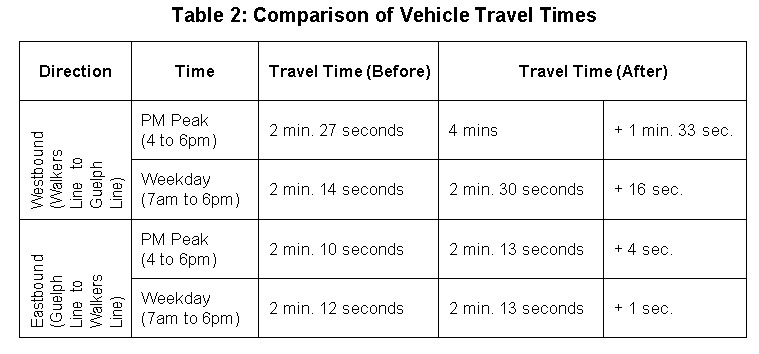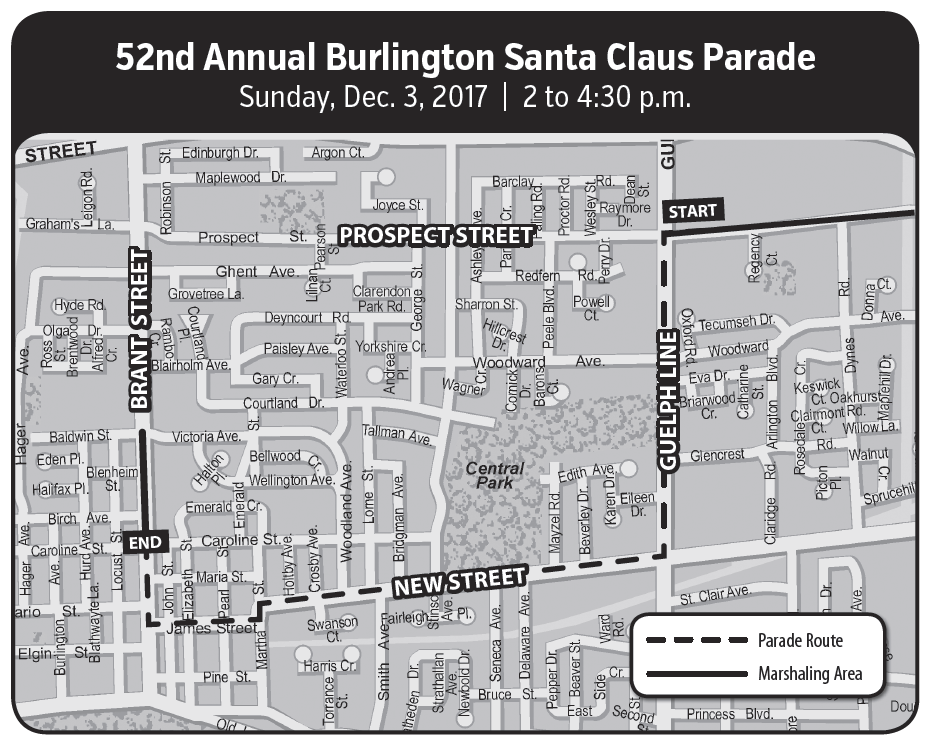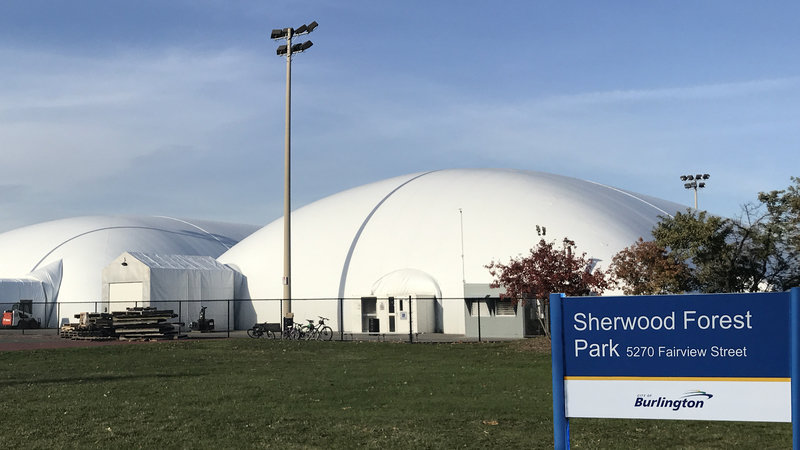 By Pepper Parr
By Pepper Parr
November 20th, 2017
BURLINGTON, ON
It was direct and to the point – the New Street Road Diet was to come to an end with instructions to the Director of Transportation that will be debated at city council November 27th.
Direct the Director of Transportation Services to convert the existing bike lane pilot project (New Street from Guelph Line to Walkers Line) to the original four-lane cross section.
Assuming city council members vote to approve the staff recommendation that will bring to an end a project that was poorly designed and poorly communicated to the public.
The idea of a Road Diet was about as divisive as they get. It was so bad that the Mayor found himself being challenged at the Y when he was getting in some exercise.
New Street was having new pipes put in which meant digging up the road in stages and then re-surfacing it all. Why not use the occasion to test the idea of a road diet – which is a re-configuring of the lanes to make room for dedicated bike lanes on both sides of the road.
The cyclists loved the idea. Those who drive their cars on New Street wanted everyone to believe that the world was about to come to an end.
And that was where the issue stuck in the craw of many – they didn’t feel safe sharing a roadway with vehicles.
Many pointed out that there was an excellent trail system yards to the south.

The trail runs parallel to New Street from Rossmore in the east to Martha in the West. The completion of the Elgin Street promenade will allow cyclists to get to the canal and on into Hamilton.
Neither the Transportation department nor most of city council could tap into the public concern.
The issues wasn’t about people riding their bikes – it was where they were going to ride their bikes and how safe they would be.
The cycling lobby, and there most certainly is a cycling lobby, wanted those lanes on New Street. Those people feel safe on their bikes in almost all forms of road traffic – they would feel save on the QEW if there were a HOT bike lane.
But for the average citizen who is Ok with the idea of hoping on their bike to run a short errand or visit with a neighbour – they just didn’t want to put themselves at risk.
The Cycling Lobby didn’t take the time to fully listen to the average citizen who understands the issues – they just don’t want to put their lives on the line to support a good idea.
The report goes to a Council Committee on November 27, 2017 and then to city council for approval on December 11, 2017
This city council needs a win badly on this one.
The Staff report sets out much of the detail and data collected during the Pilot Program.

Vito Tolone, Director of Transportation had to stick handle an awkward file – he was in a no-win situation.
The transportation people convinced themselves that providing cycling facilities, particularly throughout key transportation corridors, such as New Street, served to provide more mobility choice to the residents of Burlington, and ensures that all road users, including cyclists, have access to safe facilities.
The purpose of the pilot project was to provide an opportunity to evaluate the impacts and benefits of on-road cycling
The outcomes of the pilot project were to be used to help inform the development of future cycling projects and the Cycling Master Plan Update which is currently underway.
This all started in July of 2016 when City Council approved transportation services department report with the following direction:
Direct the Executive Director of Capital Works and Director of Transportation Services to report back on the performance of the pilot project prior to the top layer of asphalt being placed on the section of New Street between Guelph Line and Cumberland Avenue;
Following Council approval, staff converted New Street (between Guelph Line and Walkers Line) from a four-lane cross section to a three-lane cross section consisting of two through lanes and a centre two-way left-turn lane. The revised three-lane cross section included buffered on-road bike lanes. The pilot officially “launched” on August 23rd, 2016.
New Street is a minor east-west arterial that runs parallel to the QEW and Fairview Street, providing key connections to the major north-south arterial road system.
New Street accommodates both residential and commuter traffic and provides access to adjacent residential, commercial and institutional developments as well as the surrounding established neighbourhoods.

City hall went to great lengths to explain the project to the public – few people attended the information session at Bateman high school where there was a lot of detailed information.
24-hour traffic volumes along New Street range between 15,000 and 20,000 vehicles per day. Prior to installation of on-road bike lanes, an average of 60 cyclists per day used New Street.
Prior to the pilot project, this section of New Street consisted of a four-lane cross- section (two travel lanes per direction) within an overall roadway width of 14.0 metres.
The posted maximum speed limit throughout the corridor is 60 km/h exclusive of school zones.
The Pilot Project Design called for a reallocation of the existing roadway through the removal of two through vehicle lanes and introduction of a centre two-way left-turn lane. The preferred design achieved dedicated cycling facilities and reprioritized the function of the street in order to better accommodate bikes.

Lane configuration prior to the bike lane installation (left graphic) and lane configuration during the pilot project (right graphic)
3. Community Feedback
New Street has been identified as a key commuter cycling corridor given its continuous length, topography, and proximity to GO Stations. Under the previous lane configuration, New Street averaged 60 cyclists a day (June, 2016).
Installation of the pilot has increased cycling use to an average of 80 cyclists per day. Cycling volume data was obtained from a traffic camera situated at the intersection of New Street and Cumberland Avenue.
Based on feedback received from bike lane users, the pilot project has increased levels of comfort, safety and enjoyment of this mode of travel. Users also noted that extending the buffered bike lanes to Burloak Drive and connect to cycling infrastructure in Oakville should be pursued.
Vehicle volumes were collected using automatic traffic recorders used to measure the volume, direction of traffic flow, traffic speed and vehicle classification.
Recognizing that a reduction in lane capacity on New Street had potential to result in diversion, traffic data was collected to substantiate the impact of the pilot project to nearby neighbourhood streets.
 The most notable change in traffic volumes (net increase) was recorded along Woodward Avenue where the daily traffic volumes rose by 16% and while the volume is within acceptable limits of the roadways classification it is an increase nonetheless. The pilot project resulted in negligible impacts to the other surrounding roadways.
The most notable change in traffic volumes (net increase) was recorded along Woodward Avenue where the daily traffic volumes rose by 16% and while the volume is within acceptable limits of the roadways classification it is an increase nonetheless. The pilot project resulted in negligible impacts to the other surrounding roadways.
Vehicle travel times were recorded before and during the pilot project in order to quantify the increase in travel times as a result of reducing lane capacity and introduction of on-road bike lanes. Bluetooth technology was utilized as a means to collect a large data sample of vehicles (30,000 vehicle sample) traveling through a predetermined section of the corridor.
Vehicle travel times were recorded before and during the installation of the pilot project and excluded the period during which watermain and other sewer work was actively under way and disruptive to traffic flow.
 Data collected under stabilized conditions (post watermain work) indicates that the travel times have increased on average by approximately one and a half minutes during the evening peak hour in the westbound direction.
Data collected under stabilized conditions (post watermain work) indicates that the travel times have increased on average by approximately one and a half minutes during the evening peak hour in the westbound direction.
Collision experience was also examined as part of the evaluation of the pilot project. Before and after analysis appears to indicate a downward trend, however, with less than one year of collision data available under unimpeded road pilot conditions, staff are not comfortable drawing conclusions as it relates to the overall safety of New Street.
Staff received over 1100 comments and suggestions via e-mail, telephone, social media and in person. Feedback predominantly showed a lack of support for the on-street bike lane installation. Increase to travel time, increased traffic congestion and lack of use by cyclists were recurring themes in opposition to the pilot project.

It was all hands on deck – the city was promoting the use of bicycles – that got Ward 2 Councillor Marianne Meed Ward on her bike – not something seen very often,
Positive feedback cited sense of improved traffic and safety conditions for those residents who reside on New Street. Cyclists who utilized the on-road bike lanes noted that they experienced greater comfort and convenience and felt they promoted safer cycling.


Cycling Master Plan Update
The 2009 Council approved Cycling Master Plan is currently being updated to determine the next critical steps in the evolution of the city’s cycling infrastructure. The focus of this study, which is being undertaken by Alta Planning and Design and led by Transportation Services staff, is to provide guidance and expert opinion on facility types and locations and to recommend a minimum network for cycling in the City of Burlington.
Within the scope of this study, New Street was examined to confirm its suitability as an east-west cycling spine and evaluate the most appropriate type of cycling for the corridor. The existing buffered on road bike lanes were not identified to be problematic and are an appropriate facility type, however, based on a preliminary review, a continuous higher order cycling facility on New Street would provide an important east- west connection for the City and is more likely to generate new cyclists to the corridor.
Transit Network
In recent months, Transit, Planning and Transportation staff have been working together towards developing a frequent transit network for the City of Burlington. The lane configuration on New Street was to play a prominent role in providing the necessary road infrastructure to accommodate high frequency transit service. From a transit perspective, a four-lane cross section best serves the needs of passengers when being dropped off at the curb without blocking bicycle traffic and having to merge back into traffic flow.
While cycling numbers have increased by 20 per day along the New Street corridor, it is not apparent that it can be attributed solely to the on-road bike lanes. Vehicle travel times have risen somewhat and traffic diversion to parallel routes has also increased.
Before and after collision data does not provide any conclusive evidence of any safety improvement at this time. Future frequent transit service along New Street is better served by a four-lane cross section.
An increase in cycling volume is not the only measurable considered however, with no clear indication that cycling volumes have increased as a result of the pilot coupled with the negative impacts to travel times, diversion and future transit, staff do not recommend carrying on with the pilot project or extending it to Burloak Drive.
New Street provides an opportunity to create a critical spine for a cycling network in the City of Burlington. The length, location and cross section can accommodate a number of alternative cycling facility types. The test of any selected facility is its ability to attract more regular everyday “commuter” type users if we are to achieve the goal within our strategic plan of a higher cycling modal share.
After considering which facility best fits our goal to increase the cycling mode share, staff have concluded that dedicated, off road paved cycle tracks provide the greatest advantage.
The cycle track option was presented in transportation services department report TS- 10-16 in July 2016 with some preliminary assessment completed to determine cost implications. Recognizing the considerable cost of such a facility, staff recommend pursuing senior government funding which has been available in the past for cycling related infrastructure.
Next Steps – New Street Resurfacing:
Resurfacing of New Street from Cumberland Avenue to Walkers Line was included in the 2017 Capital Budget and was deferred to provide for full test of the New Street pilot project. With Council approval of this report the lane configuration for New Street will be confirmed and the resurfacing of New Street from Guelph Line to Walkers Line can be completed. The total cost including, inspection, testing, net HST and contingency is $650,000.

The dedicated cycling lanes were not fully tested – road re-surfacing, sewer main replacement and repairs got in the way of a full fledged test.
Storm Sewer Repairs
During completion of the asphalt rehabilitation on New Street, east of Guelph Line a significant storm sewer failure occurred. Upon detailed investigation, it was determined that full replacement of 340 metres storm sewer and 3 maintenance holes was warranted. To ensure motorist safety and have the work completed as soon as possible to allow the road lanes impacted to be reopened; King completed much of this work in 2017, with a small section of sewer work still to be completed. The additional cost to complete the storm sewer replacement is estimated to be $335,000. The total cost including, inspection, testing, HST and contingency is $392,000.
Public Engagement Matters:
In the Staff report that will go to the Standing Committee on the 27th, they say: City staff created a project website (www.burlington.ca/newstreetpilot ) where all the information was posted and where residents were able to provide their input.
Based on the emails, letters, social media posts and telephone conversations, staff produced a summary of comments received in favour and opposition of the pilot project. As part of public engagement, staff also received a petition that contained over 2,700 signatures of Burlington residents who are in opposition to the pilot project.
Conclusion:
The evaluation and subsequent analysis indicates that desired increase in cycling activity has not materialized based on the data collected before and after the pilot project. It is difficult to confidently attribute the increase in bicycle volume of 20 per day solely on the buffered bike lanes. However, there is also a recognition that the cycling volume may have been negatively impacted by the limited length and lack of connectivity to a larger east-west cycling network.
Travel time, during the evening peak hour has increased and while not excessive, does add time to motorists evening commute. There has been some nominal traffic diversion to Spruce and Woodward Avenues and while considered to be within the volume threshold of both roadways classification, it is not the function of a collector roadway to facilitate what is essentially “through” volume.
New Street is expected to play an important role in supporting a frequent transit network that is currently being evaluated. The preferred lane configuration for higher frequency transit operation on New Street is a four-lane cross section.
Cycle tracks, provide the greatest level of protection and encourages more people to use cycling as a commuting mode of transportation. Increasing the cycling mode share is aligned with the goals and objectives of the Strategic Plan and upcoming Transportation Plan.
The implementation of cycle tracks on New Street presents funding challenges, however, senior levels of government are continuing to invest in cycling infrastructure and New Street is an ideal candidate for consideration. Staff will consider for inclusion, the implementation of cycle tracks in the capital budget and forecast in future years and will continue to pursue funding opportunities from both the provincial and federal governments.
This is a Staff recommendation that Council will take to – Councillor Jack Dennison will remonstrate over the missed opportunity to get more people out on bikes – the two women who brought in several thousand signatures on a petition will sleep well when city council kills the idea on December 11th.

 By Staff
By Staff
























 And sometimes actions and words can be ambiguous. A victim needs to be sure that harassment is what it seems before crying out, in case that cry turns out to be ‘wolf’ and the situation between them becomes intolerable. To that end the Ontario’s Human Rights Commission cautions that harassment needs to be seen in the context of a process – when it comes to words a single vexatious comment is insufficient. Because in the end nobody wants to be victimized twice.
And sometimes actions and words can be ambiguous. A victim needs to be sure that harassment is what it seems before crying out, in case that cry turns out to be ‘wolf’ and the situation between them becomes intolerable. To that end the Ontario’s Human Rights Commission cautions that harassment needs to be seen in the context of a process – when it comes to words a single vexatious comment is insufficient. Because in the end nobody wants to be victimized twice. Ray Rivers writes weekly on both federal and provincial politics, applying his more than 25 years as a federal bureaucrat to his thinking. Rivers was a candidate for provincial office in Burlington in 1995. He was the founder of the Burlington citizen committee on sustainability at a time when climate warming was a hotly debated subject. Tweet @rayzrivers
Ray Rivers writes weekly on both federal and provincial politics, applying his more than 25 years as a federal bureaucrat to his thinking. Rivers was a candidate for provincial office in Burlington in 1995. He was the founder of the Burlington citizen committee on sustainability at a time when climate warming was a hotly debated subject. Tweet @rayzrivers




 I am really enjoying the multi-episode feature – The Fall with Gillian Anderson – she of XFiles fame.
I am really enjoying the multi-episode feature – The Fall with Gillian Anderson – she of XFiles fame.















 The most notable change in traffic volumes (net increase) was recorded along Woodward Avenue where the daily traffic volumes rose by 16% and while the volume is within acceptable limits of the roadways classification it is an increase nonetheless. The pilot project resulted in negligible impacts to the other surrounding roadways.
The most notable change in traffic volumes (net increase) was recorded along Woodward Avenue where the daily traffic volumes rose by 16% and while the volume is within acceptable limits of the roadways classification it is an increase nonetheless. The pilot project resulted in negligible impacts to the other surrounding roadways. Data collected under stabilized conditions (post watermain work) indicates that the travel times have increased on average by approximately one and a half minutes during the evening peak hour in the westbound direction.
Data collected under stabilized conditions (post watermain work) indicates that the travel times have increased on average by approximately one and a half minutes during the evening peak hour in the westbound direction.







 Lesley Mansfield, the Executive Director of the Foundation reports that “This year’s Benefit Bash was one of the most successful to date, raising almost $89,000 in support of Halton District School Board students in need. Demand from schools to help vulnerable students is up more than 40% this year to date, so these funds are critical to ensure we can continue saying ‘yes’ to requests for support.”
Lesley Mansfield, the Executive Director of the Foundation reports that “This year’s Benefit Bash was one of the most successful to date, raising almost $89,000 in support of Halton District School Board students in need. Demand from schools to help vulnerable students is up more than 40% this year to date, so these funds are critical to ensure we can continue saying ‘yes’ to requests for support.” The Foundation provides financial support and is one of those early indicators of where there are real on the ground needs that often don’t get detected.
The Foundation provides financial support and is one of those early indicators of where there are real on the ground needs that often don’t get detected.


 Dave Barry used art to talk about what war at a presentation he made at the Teresa Seaton Gallery on NAME Saturday afternoon.
Dave Barry used art to talk about what war at a presentation he made at the Teresa Seaton Gallery on NAME Saturday afternoon.







